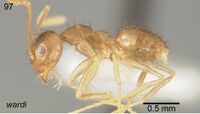Nylanderia wardi
| Nylanderia wardi | |
|---|---|

| |
| Scientific classification | |
| Kingdom: | Animalia |
| Phylum: | Arthropoda |
| Class: | Insecta |
| Order: | Hymenoptera |
| Family: | Formicidae |
| Subfamily: | Formicinae |
| Tribe: | Lasiini |
| Genus: | Nylanderia |
| Species: | N. wardi |
| Binomial name | |
| Nylanderia wardi LaPolla & Kallal, 2019 | |
Nothing is known about the biology of Nylanderia wardi.
Identification
LaPolla and Kallal (2019) - Larger brown to light brown species (HL: 0.6–0.72); SMC typically greater than 30 (measured range: 26–38); head in full-face view distinctly ovate with rounded posterolateral corners.
Compare with: Nylanderia sierra, Nylanderia xestonota
Workers of this species are very similar to N. sierra, but N. wardi is much larger and the declivity following the mesonotum to the metanotal area is distinctly longer in N. wardi. Additionally, N. wardi has much more scape macrosetae than N. sierra. There were individuals of N. sierra collected in sympatry with N. wardi and the morphological differences between the two species were maintained.
Keys including this Species
Distribution
Latitudinal Distribution Pattern
Latitudinal Range: 20.007° to 20.007°.
| North Temperate |
North Subtropical |
Tropical | South Subtropical |
South Temperate |
- Source: AntMaps
Distribution based on Regional Taxon Lists
Neotropical Region: Cuba (type locality).
Distribution based on AntMaps
Distribution based on AntWeb specimens
Check data from AntWeb
Countries Occupied
| Number of countries occupied by this species based on AntWiki Regional Taxon Lists. In general, fewer countries occupied indicates a narrower range, while more countries indicates a more widespread species. |

|
Estimated Abundance
| Relative abundance based on number of AntMaps records per species (this species within the purple bar). Fewer records (to the left) indicates a less abundant/encountered species while more records (to the right) indicates more abundant/encountered species. |

|
Biology
Castes
Nomenclature
The following information is derived from Barry Bolton's Online Catalogue of the Ants of the World.
- wardi. Nylanderia wardi LaPolla & Kallal, 2019: 441, figs. 97-99 (w.) CUBA.
Unless otherwise noted the text for the remainder of this section is reported from the publication that includes the original description.
Description
Worker
(n=7): TL: 2.20–2.84; HW: 0.54–0.6; HL: 0.60–0.72; EL: 0.15–0.18; SL: 0.78–0.87; WL: 0.76–0.85; GL: 0.82–1.3; SMC: 26–38; PMC: 4–6; MMC: 3–4. indices: CI: 83–90; REL: 24–25; SI: 141–152; SI2: 18–21.
Head: Sides of head in full face view rounded and slightly convergent anteriad; posterolateral corners distinctly rounded; posterior margin straight; anterior clypeal margin emarginate; median ocellus present; eye well-developed. Mesosoma: in lateral view, pronotum convex; anterior margin of mesonotum raised slightly above posterior pronotal margin; metanotal area without short flat area before spiracle; dorsal face of propodeum slightly convex; dorsal face of propodeum lower than mesonotum in lateral view. Color and pilosity: color light brown to brownish-yellow; slightly darker dorsally; mesocoxae and metacoxae slightly lighter than the mesosoma; head generally without pubescence, except some sparse pubescence laterally and underneath eyes; mesosoma generally without pubescence, except some sparse pubescence on the mesonotum and a sparse fringe along dorsal face of propodeum; gastral tergites with abundant pubescence.
Type Material
Holotype worker, CUBA: Holguin, 6 km S Yamanigüey, 20° 33’ N, 74° 44’W, 25 m, 23.viii.2001, P.S. Ward #1443723 (National Museum of Natural History); 2 paratype workers same locality data as holotype (specimens are from the same nest as holotype); 3 paratype workers same locality data as holotype but different collecting code (P.S. Ward #14436) (NMNH & Museum of Comparative Zoology).
Etymology
Named in honor of Philip S. Ward (University of California—Davis), who not only collected this species, but whose many superb contributions to myrmecology have greatly enriched the field.
References
References based on Global Ant Biodiversity Informatics
- LaPolla J. S., and R. J. Kallal. 2019. Nylanderia of the World Part III: Nylanderia in the West Indies. Zootaxa 4658: 401-451.

